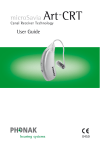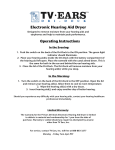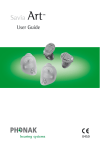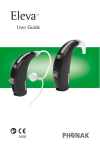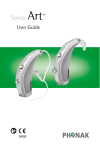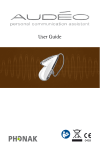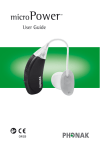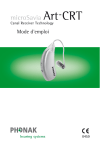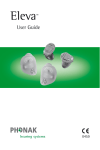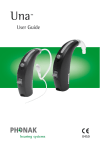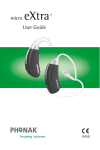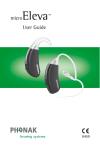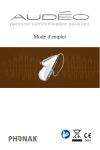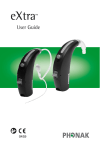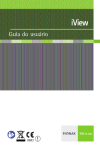Download User Manual microSavia Art
Transcript
microSavia User Guide 0459 Art ™ Contents Welcome 4 Description 5 Preparation Replacing the battery Identifying left and right hearing systems Inserting microSavia Art hearing system with micro tube into your ear Inserting microSavia Art hearing system with earmold into your ear Fine tuning your microSavia Art hearing systems 6 6 10 18 Operation Switching ON/OFF Remote control (optional) Wireless Systems – MyLink (optional) 20 20 21 25 Maintenance Microphone Protector Micro tube and dome Important points 29 29 30 35 11 15 Warning 37 Service and Warranty 38 Phonak distributors worldwide 40 Welcome Congratulations on choosing the microSavia Art hearing system, one of the smallest and most sophisticated behind-the-ear instrument from Phonak. microSavia Art uses the latest advances in digital hearing technology to offer you the ultimate combination of hearing miniaturization, hearing performance and comfort. This inconspicuous hearing system provides you – in a fully automatic manner – with the highest sound quality, speech understanding and listening comfort in all your personal hearing situations. microSavia Art is a quality product developed by the Swiss company Phonak, a world leader in hearing technology, innovation and reliability. Please read this manual carefully to benefit from all features of your new hearing system. With proper care and usage, your microSavia Art will support your hearing and understanding for many years. If you want additional information about microSavia Art, please visit the Phonak website www.phonak.com Phonak – your partner for good hearing! 4 Description microSavia Art hearing system with micro tube Microphone inputs with Microphone Protector Battery compartment with ON/OFF switch (two sizes: 312 standard, 10 option) Micro tube (sound output) Dome Retention microSavia Art hearing system with earmold – see above Hook /sound output Individual earmold 5 Preparation Replacing the battery Using the nail grip , open the battery compartment completely and remove the old battery . Remove the protective foil from the new battery . 6 Insert the new battery with the “+” sign (flat side of the battery) in line with the “+” marked on the battery compartment and close it . 7 Preparation Replacing the battery Handle the battery compartment with care and do not use excessive force. If there is any resistance when shutting the compartment, ensure that the battery is inserted correctly. The compartment may not close properly if the battery is upside down, and the instrument will not work. When your hearing system is not in use, leave the battery compartment open to allow any moisture to evaporate. We recommend to only use batteries which your hearing care professional approves and sells. 8 Low battery warning An acoustic signal gives you an early warning that the battery is approaching exhaustion. Usually you have at least 30 minutes to replace the battery. With very high quality batteries, this reserve may be much higher and the hearing system will repeat the low battery warning approximately every 30 minutes. Note: Your microSavia Art hearing system offers the unique possibility to be operated either with size 312 (standard) or size 10 batteries (option). Your hearing care professional may modify the devices accordingly. The 312 battery lasts longer and is easier to handle, the 10 battery creates an even small overall instrument size (refer to picture below). 10 battery 312 battery 9 Preparation Identifying left and right hearing systems It is important to use the correct hearing system for each ear. Your hearing care professional can mark the hearing systems for you with a color code placed on the case under the nail grip of the battery compartment. The color code is visible when the battery compartment is opened. It will identify left and right instruments as follows: red = right hearing system blue = left hearing system 10 Inserting microSavia Art hearing system with micro tube into your ear Open domes: Place the hearing system over the top of your ear . 11 Preparation Hold the micro tube where it attaches to the dome and gently push the dome into your ear canal. The dome should be placed far enough into the ear so that the micro tube lies flush with your head. Place the retention tail of the micro tube into the bowl of your concha . 12 Closed domes: The closed dome has a different design than the open dome, refer to picture (page 14). The closed dome consists of two fins overlapping each other. Before inserting the closed dome into the ear canal it is important to check the position of these fins. The bigger fin must be positioned over the smaller fin, see picture . If the position is incorrect , you can easily adjust it with one finger, just bend smoothly the bigger fin forwards and then back again so that it is overlapping the smaller one, see picture . Make also sure that the slit of the closed dome is in a horizontal position on the tube unit, as shown in picture . Your closed dome and external receiver unit is ready to be inserted into the ear, refer to page 11. 13 Preparation Correct position Wrong position Moving the fins 14 Inserting microSavia Art hearing system with earmold into your ear Using the hand on the same side you wear your hearing system, grasp the earmold between the thumb and index finger. Raise your hand to your ear making sure the canal portion of the earmold faces your ear. Tilt your hand slightly forward. 15 Preparation Place the canal portion of the earmold inside your ear canal. If it is difficult to get it into place, stretch your ear by pulling it gently backwards and upwards with your other hand. When the canal portion is in place, twist the earmold backwards so that it fits into the concha and the helix portion is under the fold. 16 Check the placement of the earmold by tracing the contour of the ear with your finger. To remove your hearing system, grasp the earmold and not the tubing and pull it out of your ear gently but firmly. 17 Preparation Fine tuning based on your personal preferences The fitting process has limited capabilities of reproducing the full spectrum of your personal sound environments. This limitation is now overcome by the ability of microSavia Art hearing system to learn from your real life volume adjustments. microSavia Art hearing system offers a unique functionality called “Self Learning”. In every environment, it logs your personal volume changes within the hearing instrument. This means that every time you change the volume of your microSavia Art hearing system, this correction is taken into account to apply your preferred volume automatically when you are in a similar environment next time. 18 Self Learning cleverly ensures that your volume corrections in each environment contribute to a fully personalized volume setting. To fully benefit from this Self Learning feature please ask your hearing care professional to demonstrate to you the available remote controls for your hearing system. 19 Operation Switching ON/OFF Switching OFF Using the nail grip, slightly open the battery cover until it snaps into its OFF position. Switching ON Close the battery compartment by pressing on the base of the instrument. Your hearing care professional may have delayed the start-up of your microSavia Art hearing system (9 or 15 seconds once it is switched on), in order to avoid any disturbance when placing it on your ear. The start-up is confirmed by an acoustic signal. 20 Telecoil (optional) Your hearing care professional may have activated a Telecoil (T-coil) in your microSavia Art hearing systems. The programs with T-coil are used to listen to telephones that are compatible with hearing system or via inductive loop systems (present in some school settings, theaters, churches etc.) as well as other solutions (e.g. Phonak MyLink FM system). Remote control (optional) Remote controls from Phonak allow for discreet and convenient control of all the functions of your microSavia Art hearing system: • Volume up • Volume down • Program selection If you wear two microSavia Art hearing systems, the remote control will simultaneously control both of them. This ensures that their volume remains binaurally balanced. 21 Operation Phonak offers a complete range of modern remote controls. Ask your hearing care professional to demonstrate them to you. Choose the model that is most convenient for your lifestyle and your taste. WatchPilot2: exclusive and modern, available for women and men, with sporty rubber band or elegant metal band. 22 SoundPilot2: direct access to all functions of your microSavia Art hearing system. KeyPilot2: small, easy and convenient. 23 Operation For best results with your KeyPilot or WatchPilot remote control, refer to photo. For detailed information on the use of your remote control, please refer to its user guide. Your hearing care professional can also print an individual description of your hearing programs for you. Do not use your remote control in locations where it is forbidden to use electronic devices, for instance in airplanes. 24 Wireless Systems – MyLink (optional) Your microSavia Art hearing system allows you to fully benefit from the Wireless Systems from Phonak. Wireless Systems greatly improve communication when noise, distance or reverberation is a problem. A Wireless System consists of a transmitter (e.g. SmartLink SX or EasyLink) and a receiver (MyLink). The transmitter is placed near the sound source. It may also be directly connected to your TV set, radio or telephone or linked via Bluetooth to your mobile phone. The signal is transmitted wirelessly via the MyLink receiver to your microSavia Art hearing system. The MyLink receiver can be worn over or under your clothes. 25 Wireless Systems – MyLink (optional) Using MyLink 1) Wear MyLink around your neck 2) Switch MyLink ON 3) Switch the transmitter ON (e.g. SmartLink SX) by holding it in front of you, from a distance of 20-30 cm (8-12 inches). 26 The transmitter automatically selects the telecoil and microphone program of your microSavia Art so you can hear the voice picked up by the transmitter and the voice picked up by the hearing system’s microphone. 4) Your Wireless System is now ready to operate. To increase / decrease the volume of the wireless signal, use the MyLink volume control. Volume up Volume down 27 Wireless Systems – MyLink (optional) For SmartLink users: To increase/decrease the volume of the microSavia Art system, press here: Please consult the SmartLink SX or EasyLink User Guide to fully benefit from your Wireless System in all the different use cases. 5) Switch MyLink OFF 28 Maintenance Microphone Protector Important: The Microphone Protector is an exclusive Phonak system designed to protect the microSavia Art high-tech microphones from dirt, which may damage them. The Microphone Protector can be replaced if needed. Your hearing system should never be used without the Microphone Protector. Your hearing care professional can tell you whether the Microphone Protector should be exchanged or not. Important: Consult your hearing care professional about changing the Microphone Protector if you experience any of the following: • • • • The hearing system sounds quieter than usual. There is a reduction in sound quality. Understanding in noise becomes more difficult. It becomes more difficult to determine the direction of sounds. 29 Maintenance Micro tube and dome The following care and maintenance instructions will help extend the life span and ensure the quality and comfort of your microSavia Art hearing system. The micro tube feeds the amplified sound from the hearing system into the ear. It is important that the micro tube and the dome fit correctly into your ear. If the micro tube or the dome irritates your ear in any way and prevents you from wearing your hearing system, please contact your hearing care professional. You should never attempt to modify the shape of the micro tube yourself. The micro tube and the dome should be cleaned regularly, according to the following instructions: 30 Detach the micro tube from the hearing system as follows: • Hold the micro tube in one hand and the hearing instrument in the other hand. • Gently twist the micro tube 90° and pull it straight out, away from the hearing instrument . 90° 31 Maintenance Use a damp cloth to clean the outside of the micro tube and dome. Use the cleaning rod to clean the inside of the micro tube and dome. Gently insert the cleaning rod where the micro tube attaches to the hearing system and push it all the way through the micro tube and out through the dome . After cleaning it is important to remove the cleaning rod. 32 Attach the micro tube onto the hearing system as follows: • Hold the micro tube in one hand and the hearing system in the other hand. • Push the micro tube on to the hearing system until it is snug . 33 Maintenance The micro tube and dome should never be submerged or rinsed in water, as there is a risk that a water drop may become lodged in the micro tube. If this should occur, it will prevent sound from coming through the micro tube, and may be harmful to the hearing system’s electronics. The micro tube and dome should be changed every three months or sooner if the micro tube becomes stiff or brittle. Only your hearing care professional should change the dome. This is to prevent the dome from detaching from the micro tube during insertion into the ear. 34 Important points 1) Always use new batteries as replacements. You can return empty batteries to your hearing care professional. 2) Protect your hearing system from excessive moisture and heat. Always remove your hearing system before showering, bathing or swimming. Do not leave your hearing system near windows or in a car. Avoid strong jolts and vibration. 3) Daily cleaning and the use of a drying system is highly recommended. We recommend C&C Line from Phonak to care for your microSavia Art hearing system. Your hearing care professional will gladly advise you. Never use household cleaning products (washing powder, soap, etc.) to clean your hearing system. 4) Hair spray, face creams and make-up can damage your hearing system. Remove the instruments before applying cosmetics. 35 Maintenance 5) If you experience any soreness or inflammation in or behind your ear, contact your hearing care professional. 6) If your hearing system fails to operate after you have correctly inserted new batteries, contact your hearing care professional for advice. Please remember to also bring your remote control, if you use one, together with your hearing system for service inquiry. The symbol with the crossed out disposal bin indicates that this hearing instrument shall not be treated as household waste. Please hand over your old or unused hearing instrument to the applicable collection point for the recycling of electrical and electronic equipment or bring your old hearing instrument to your hearing care professional for appropriate disposal. By ensuring this product is disposed of correctly, you will help prevent potential negative effects on the environment and human health. 36 Warning In very rare cases, the dome can remain in the ear canal when removing the external receiver unit from the ear. In the unlikely case that any parts remain in the ear canal, it is strongly recommended to see a medical specialist for safe removal. Hearing systems batteries are toxic when swallowed! Keep them out of reach of children and pets. If batteries are swallowed, please seek the advice of a medical practitioner! Use only hearing systems that have been specially programmed for you by a hearing care professional. Other instruments may be ineffective and may, in certain cases, even damage your hearing. X-ray radiation (e.g. CT scans, MRI scans) may adversely affect the correct functioning of your instruments. We recommend that you remove them before undergoing X-ray procedures and keep them outside the room. Hearing systems in directional microphone mode (dSZ) reduce mainly background sounds. Warning signals coming from behind and vehicles’ horns approaching from behind are partially or completely suppressed. 37 Service and Warranty Phonak offers you a comprehensive global warranty which becomes effective on the date of purchase. Please ask your hearing care professional about the details and duration. This warranty covers any repairs due to defects in material and/or workmanship. The warranty does not cover damage from improper handling or care, exposure to chemicals, immersion in water or undue stress. Damage caused by third parties or non-authorized service centres renders the Phonak warranty null and void. This warranty does not include any services performed by a hearing care professional in his office. This warranty applies to the Phonak products listed below: Serial number instrument – right: Date of purchase: 38 Serial number instrument – left: 39 Phonak distributors worldwide Group companies: Australia Austria Belgium Brazil Canada China Denmark France Germany India Italy Japan Jordan Mexico Netherlands New Zealand Norway Poland Portugal Russian Federation (detailed information on www.phonak.com) Phonak Australasia Pty. Ltd. Baulkham Hills N. S. W. 2153 Hansaton Akustische Geräte GmbH 5020 Salzburg LEts Lapperre B.H.A.C. NV, 1702 Groot-Bijgaarden Phonak Belgium NV, 1700 Dilbeek CAS Produtos Médicos, São Paulo – SP 04363-100 Phonak Canada Limited, Mississauga Ontario L5W 0B3 Phonak (Shanghai) Co. Ltd., Shanghai City 200233 Phonak Danmark A/S, Nitivej 10 2000 Frederiksberg Phonak France SA, 69500 Bron Phonak GmbH, 70736 Fellbach-Oeffingen EC Representative India Phonak India Pvt. Ltd., 100 034 New Delhi Phonak Italia S.r.l., 20159 Milano Phonak Japan Co., Ltd., Tokyo 101-0044 Phonak Middle East, 11181 Amman Phonak Mexicana, S.A. de C.V. 03920, México, D.F.MEXICO Phonak B.V., 3439 ME Nieuwegein Phonak New Zealand Ltd., Takapuna Auckland 9 Phonak AS, 0105 Oslo Phonak Polska Sp. z o.o., 00-567 Warszawa Phonak Ibérica S.A., 03008 Alicante, Spain Phonak CIS Ltd., Moscow, 115114 Spain Sweden Switzerland Turkey United Kingdom USA Independent general distributors: Manufacturer: Phonak Ibérica S.A., 03008 Alicante Phonak AB, 117 43 Stockholm Phonak AG, Phonak Schweiz, 8712 Stäfa Phonak Turkey A.S., 34357 Istanbul Phonak UK Limited Warrington, Cheshire WA1 1PP Phonak LLC, Warrenville, IL 60555-3927 A complete list of Phonak distributors is available at Phonak's Internet site: www.phonak.com. Please visit us or ask your hearing care professional for information. Phonak AG, Laubisrütistrasse 28 CH-8712 Stäfa, Switzerland 41 The CE symbol is confirmation by Phonak AG that microSavia Art products and accessories meet the requirements of directive 93/42/EEC on medical devices. This symbol indicates that microSavia Art products comply with requirements for a BF type applied part according to EN 60601-1. This symbol indicates that it is important that the user refers to associated warnings given in this user guide. Safety notice External devices may only be connected if they have been tested in accordance with corresponding IECXXXXX standards. Only use accessories approved by Phonak AG. Operating conditions The hearing system has been designed for trouble-free operation under all ordinary climatic conditions. Transportation Temperature should not exceed limits of –20°/60° and storage Celsius at a relative air humidity of 65% for extended conditions periods during transportation and storage. Air pressure between 500 and 1100 hPa is not detrimental to the instrument. 42 0459 43 www.phonak.com 029-0034-02/V2.00/2008-05/A+W Printed in Switzerland © Phonak AG All rights reserved Your hearing care professional:












































